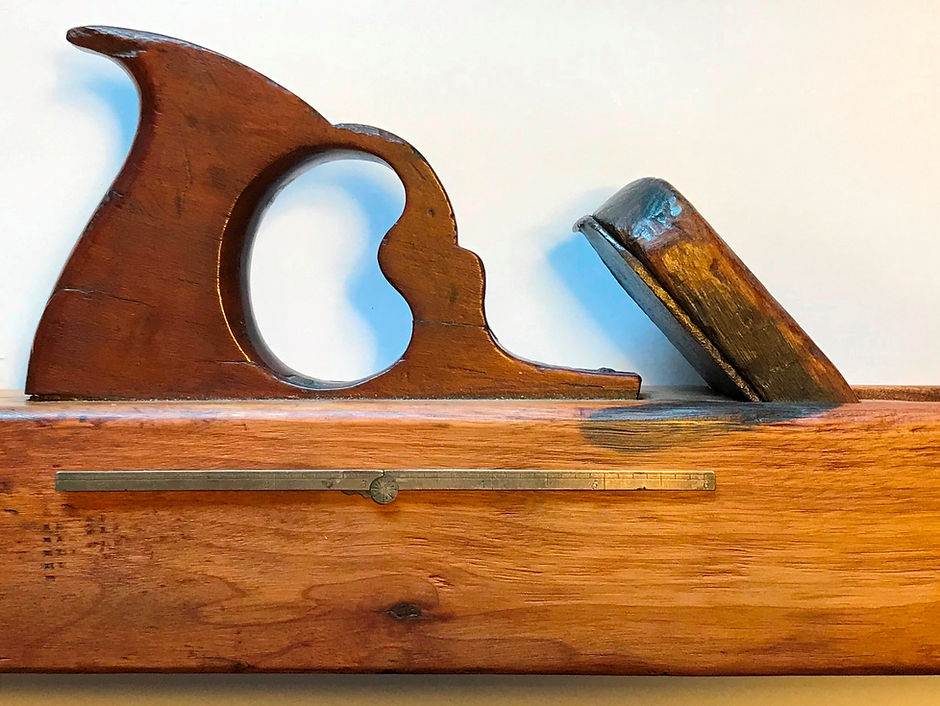E Clark Jointer Planes
Elisha Clark (1752-1835)
Middleboro, MA

Mid-period jointer (see Clark / Bisbee section below)
25 5/8" long by 3" wide
3 9/16" high tote
1/4" heavy round chamfers on top of body and 1/4" flat chamfers on ends with flutes
birch






Early-period jointer
-
flat body chamfers on top of body as well as on the ends
-
flat straight chamfers on wedge abutment cheeks
From the Bisbee family collection. (see Clark / Bisbee section below)


Early-period Elisha Clark jointer (rear) and mid-period Elisha Clark jointer (front) from Bisbee family collection.

Front to back: mid-period Clark, early-period Clark, unmarked Bisbee jointers.

Description of Clark and Bisbee jointers from The Chronicle article, Levi Bisbee and Elisha Clark, 2015, vol 68 no 2.
“Amongst the Bisbee family heirlooms were some of Levi Bisbee’s furniture along with his mentioned woodworking tools and workbench. These items had been passed down through multiple Bisbee generations. In all, six Bisbee generations had lived in the North Rochester house that Levi’s father, Hopestill, had built in 1771.” “The tools consisted of four early bench planes, one early crown molder …” “Two planes were unmarked but three of the planes were marked E Clark / Middleboro!”
“What is particularly interesting is that the E Clark jointer planes were not of the same age. One of the E Clark jointers is an early piece ca. 1780 and the second is a “mid-period” piece ca 1790-1800.” (Note that “mid-period” and “early” are the author’s/editor’s designations.)
“Perhaps the age span of the planes speaks to an ongoing association between the two men in addition to the apprenticeship period of 1794 through circa 1797. Of the two “E Clark” jointers, the mid-period jointer has more wear. In fact, the earlier jointer has very little wear.” “The early E Clark jointer is 28 5/8" long and is 3 1/8" wide. The body chamfers are flat as are the cheek chamfers on the wedge abutments. The chamfers on the two ends end with flute details similar to H. Wetherel and Jo, Fuller. The “mid-period” jointer is 27" long and 2 7/8” wide. It has later features including heavy rounded chamfers on the top of the body with flat chamfers on the ends. The flute details remain the same. The chamfers on the wedge abutments are slightly rounded…but mostly indistinct. The iron’s bed is steeper than is “standard”. Both totes of the E Clark jointers are identical and are offset by the same amount. The “mid-period” E Clark plane” presented at the start of this piece …. “is nearly identical to the Bisbee “mid-period” E Clark jointer…except for the iron bed angle.”
“The final Bisbee E Clark plane appears to be a crown molder with the offset tote broken off. This plane has traits closer to the “mid-period” jointer.”
The set of Clark and Bisbee planes from the Bisbee family

Possible Henry Wetherel links from The Chronicle article, Levi Bisbee and Elisha Clark, 2015, vol 68 no 2.
“Possible Henry Wetherel links.
In AWP4, the observation was made that E Clark might have apprenticed to Henry Wetherel. This consideration is based on similarities between E Clark / Middleboro molders and H Wetherel / In Norton molders made before 1790. In particular, the fluted chamfer stops and wedges are very close between the two makers. Now … consider the jointer planes. First the totes: “ (See the mid-period E Clark / Middleboro tote photo and the H Wetherel / Chatham tote photos below)
“For scale, each tote height is 3 ½” plus or minus 1/16”.
“In all respects, aside from the front nib on the Wetherel tote, the tote details are identical. It has been …” (the author’s experience) … “that tote details are amongst the most telling of any bench plane traits when comparing maker linkages and regional influences. They seem to be the most personal signature of a maker.” “Considering these two planes”…. (the author) … did not “know of any other named 18th century closed tote examples which used this same combination of design details in quite the same way. “ “The flat chamfer details of the wedge abutment cheeks are also nearly identical, although this trait is in general, less definitive.” The author then left to the reader …. “the possible Wetherel connection up to you, for your consideration.”

E Clark above and H Wetherel below.
